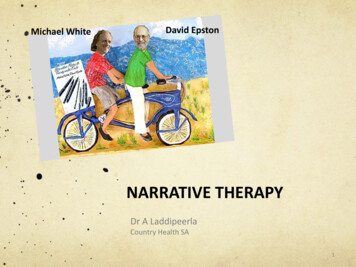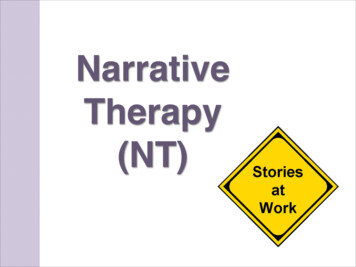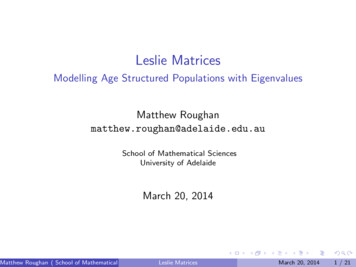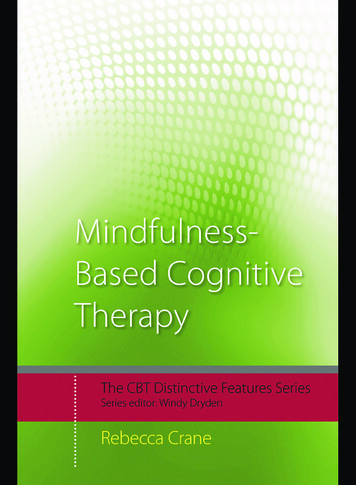
Transcription
Michael WhiteDavid EpstonNARRATIVE THERAPYDr A LaddipeerlaCountry Health SA1
Outline History Concepts Narrative Practice Applications Implications forPsychiatry Discussion2
History Both social workers and familytherapists White had experience as acommunity organizer of mentalhealth patients in Australia. In 1982he was the first editor of theAustralian and New ZealandJournal of Family Therapy (ANZJFT) Epston, hypnotist, also had adegree in anthropology, andhad studied communitydevelopment in hite-histories-and-legacies.html3
Introduction Narrative therapy views problems as separatefrom people and assumes people have manyskills, competencies, beliefs, values,commitments and abilities that will assist them tochange their relationship with problems in theirlives. There are many possible directions that anyconversation can take (there is no single correctdirection). The person consulting the therapistplays a significant part in determining thedirections that are taken.4
Narrative therapists think in terms ofstories – dominant stories andalternative stories; dominant plots andalternative plots; stories that arepowerfully shaping of lives.5
M from Fregon .her story Narrative therapists, when initially faced withseemingly overwhelming thin conclusions andproblem stories, are interested inconversations that seek out alternative stories– not just any alternative stories, but storiesthat are identified by the person as stories bywhich they would like to live their lives.6
Key question “How can we assist people to break from thinconclusions and to re-author new andpreferred stories for their lives andrelationships? ” As Jill Freedman and Gene Combsdescribe: Narrative therapists are interested inworking with people to bring forth and thickenstories that do not support or sustainproblems.7
8
PROBLEM STORIES9
ASSUMPTIONSThat people consulting ushave MEANING-MAKINGSKILLS have been developedin the history of their lives,their relationships and theircommunities10
4Account of eventsLinked in sequencethrough timeAccording to a plot/themeEg: “losing my life”“tragedy”“loss”11
Conclusions theyreach“I am inadequate”“I am a failure”“Just shows howincompetent I am”IDENTITY CONCLUSIONS12
Unfolding of eventsthrough a landscape ofaction Negative conclusions/Understanding about theiridentity that have beenconfirmed by thedevelopments: landscapeof identity material13
HOW ARE WE DOING?14
MAPPING EXTERNALISING CONVERSATIONS15
Mapping Externalising Conversations Experience-near, particular DEFINITION OF THE PROBLEM/CONCERN Experience of this Development (INFLUENCE OF THE PROBLEM in the various domainsof living) Problem in Relationship (EVALUATION OF THE EFFECTS/INFLUENCE OF THE PROBLEM)eg. Is this okay with you? Characterisation of Problem (JUSTIFICATION OF THESE EVALUATIONS) eg. Why is/isn’tthis okay for you?; Why do you feel this way about this development?16
Focus on problems that are internalised and externalise them (eg. ‘the depression’ and ‘MrMischief’). Broader considerations can also be taken into account. People’s relationships with problemsare shaped by history and culture, it is possible to explore how gender, race, culture, sexuality,class and other relations of power have influenced the construction of the problem Metaphors that become externalised (e.g. blame, bickering, guilt, worry, fear, jealousy) arethose that are articulated by the person consulting the therapist17
18
MAPPING INITIATIVES19
Mapping Initiatives Experience-near and particular DEFINITION OF THE UNIQUEOUTCOME/EXCEPTION/PROBLEM-SOLVING SKILL. EFFECTS OF THE UNIQUE OUTCOME/EXCEPTION/PROBLEM- SOLVINGSKILL in those various domains of living EVALUATION OF THE EFFECTS of the uniqueoutcome/exception/problem-solving skill in these domains of living 4. JUSTIFICATION OF THESE EVALUATIONS (Why is/isn’t this okay foryou?; How come you’re taking this stand/position on this development?;Would you tell me a story about your life that would help me tounderstand why you would take this position? )20
21
Mapping Initiatives In response to specific developments in people’s lives, it can be very tempting for therapists to respondenthusiastically to what they construe to be a unique outcomes, and in so doing: a.engage in efforts to convince persons that they could take more notice of and appreciate theseTO CONVINCEdevelopments, POINT OUTTHEimplicationsCONSEQUENCESb.try to point out theTOconsequencesor potentialof, or possibilities associated with, suchdevelopments,TAKE A STRONGLY POSITIVE POSITION c.take a strongly positive position on these consequences, implications, and possibilities, andJUSTIFY THEIR POSITION ON THESE DEVELOPMENTS d.justify their position on these developments by giving voice to a range of positive conclusions about thelives and the identities of the people seeking consultation. In responding to the developments of people’slives in this way, therapists become quite centred and relatively non-influential. These developments arejudged to be significant and weighty to therapists, but not by the people who seek consultation. In suchcircumstances, it is the therapists who are taking a primary position on various developments, not the peoplewho consult therapists. This closes the door for the development of the partnership that is the outcome oftherapists joining people in their position on the various developments of their lives. The "statement of position map 2" can assist therapists to maintain a decentred posture in theirconsultations, and contributes to the scaffolding of therapeutic conversations that provide the opportunityfor people seeking consultation to attribute significance to various developments of their lives, developmentsthat might otherwise be neglected.22
TherapistCuriosity and a willingness to ask questions to which we genuinely don’tknow the answers are important principles of this work23
Line of Question The therapist seeks to understand whatis of interest to the people consultingthem and how the journey is suitingtheir preferences.“How is this conversation going foryou? Should we keep talking about thisor would you be more interested in ?”“Is this interesting to you? ““Is this what we should spend our timetalking about?”I was wondering if you would be moreinterested in me asking you some moreabout this or whether we should focuson X, Y or Z? [X, Y, Z being otheroptions]24
RE-AUTHORING CONVERSATIONS25
RE-AUTHORING CONVERSATIONS People are assisted toidentify the moreneglected events oftheir lives Therapists build ascaffold throughquestions thatencourage people to fillthese gaps. In developing thisscaffold, therapiststraffic in "landscape ofaction" and "landscapeof identity" questions.26
A stair of questions: A scaffolding of the mapsof narrative practice Geir Lundby, Norway What is possible to knowthem?future?commitments?involved?dreams? Re-authoringto help me understand? Re-memberingWho would be surprised/not surprised?Justify theevaluationEvaluate the effectsMapping the effects on life andrelationshipsNaming the event (specific, experience-near)Positive, negative, or a bitof bothEvent, initiative, or a stepWhat might stop you from takingWhat new steps or possibilities in nearWhat aboutsome valuesWhat hopes orWhat purpose or intention was behind the step?How did you prepare yourself?Tell me story27
As re-authoring conversations evolve, they provide conditionsfor people to step into the near future of the landscapes ofaction of their lives. In the first place, people are likely to respond to landscape ofidentity questions by generating identity conclusions that areinformed by the well known structuralist categories of identity needs, motives, attributes, traits, strengths, deficits, resources,properties, characteristics, drives and so on. As these conversations further evolve, there is opportunity forpeople to generate identity conclusions that informed by thewell known non-structuralist categories of identity – intentionsand purposes, values and beliefs, hopes, dreams and visions,commitments to ways of living, and so on.28
29
RE-MEMBERING CONVERSATIONS30
RE-MEMBERINGCONVERSATIONS Evoke ‘life’ as a ‘membered’ club, ‘identity’ as an ‘association’ of life. Contribute to a multi-voiced sense of identity, rather than the singlevoiced sense of identity Open possibilities for the revision of one’s membership of life: for theupgrading of some memberships and the downgrading of others; for thehonouring of some memberships and for the revoking of others. Are richly describing of the preferred accounts of identity andknowledges of life and skills of living that have been co-generated in thesignificant memberships of people’s lives.31
RE-MEMBERINGCONVERSATIONS Evoke ‘life’ as a ‘membered’ club, ‘identity’ as an ‘association’ of life. Contribute to a multi-voiced sense of identity, rather than the singlevoiced sense of identity NOT ABOUT PASSIVE RECOLLECTION, BUT ABOUT PURPOSIVEENGAGEMENTS WITH THE SIGNIFICANT FIGURES OF ONE’S HISTORY,Openpossibilitiesfor the revisionof one’smembershiplife: for theAND WITHTHE IDENTITIESOF ONE’SPRESENTLIFE WHOofAREupgradingof somemembershipsand the downgrading of others; for theSIGNIFICANTOR POTENTIALLYSIGNIFICANT.honouring of some memberships and for the revoking of others.Are richly describing of the preferred accounts of identity andknowledges of life and skills of living that have been co-generated in thesignificant memberships of people’s lives.32
RE-MEMBERINGCONVERSATIONS The first set of inquiry: I. recounting figure’s contribution to person’s life II. person’s identity through the eyes of the figure The second set of inquiry: I. person’s contribution to the figure’s life, and II. implications of this contribution for the figure’s sense ofidentity33
Narrative therapists think in terms of stories– dominant stories and alternative stories; dominant plots and alternativeplots; stories that are powerfully shaping of lives.-Narrative therapists are interested in joining with people to explore thestories they have about their lives and relationships, their effects, theirmeanings and the context in which they have been formed and authored34
Concept of change in Narrative practiceEstablishing a context in which people are able to give voice to their values andtheir intentionsPeople become aware of a whole range of actions that are in harmony with whatthey give value toInternal changes: Influences from William James’s work and Russian psychologistVygotsky’s writings (Stream of consciousness).35
Applications Aboriginal patients, families & communitiesTrauma: DV and abuseChildren and familiesSchizophreniaEating disordersInternational: US, Africa, Bangladesh, Pakistan,Columbia36
37
Strengths/Weaknesses/Criticisms Advantages–Counseling applicability–Cultural ms–Relativistic–Nihilistic–Notion of agency nate amount oftime–Downplays the role ofexpertise - S or W?–Emphasis on language–Cultural bias / difficulties–The “blameless self”?38
39
http://www.dulwichcentre.com.au/publications.html l single-story.html ve-therapy.html40
“One of the aspects associated with this work that is of centralimportance to us is the spirit of adventure. We aim to preserve this spirit,and know that if we accomplish this our work will continue to evolve inways that are enriching to our lives, and to the lives of those persons whoseek our help” (White & Epston, 1992, p. 9).DISCUSSION 41
Narrative therapy views problems as separate from people and assumes people have many skills, competencies, beliefs, values, commitments and abilities that will assist them to change their relationship with problems in their lives. There are many possible directions that any conversation can take (there is no single correct direction).










